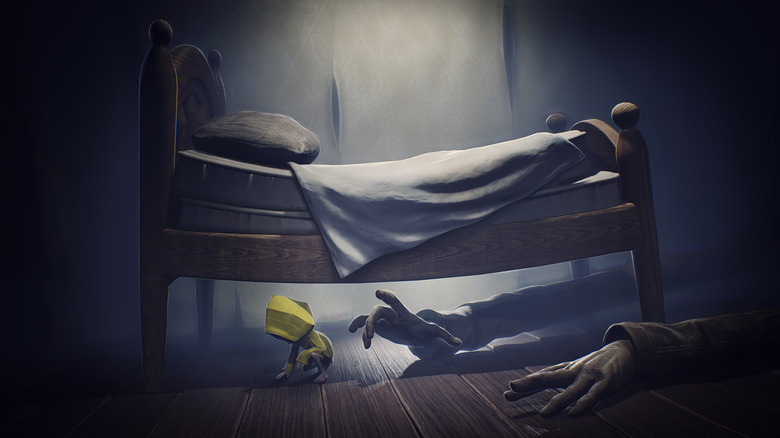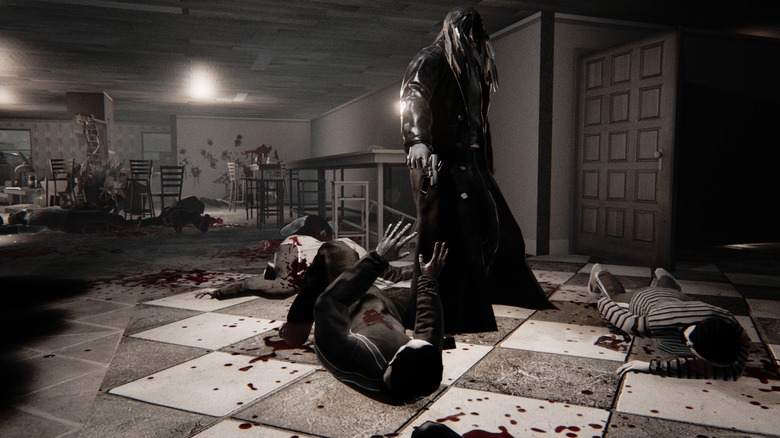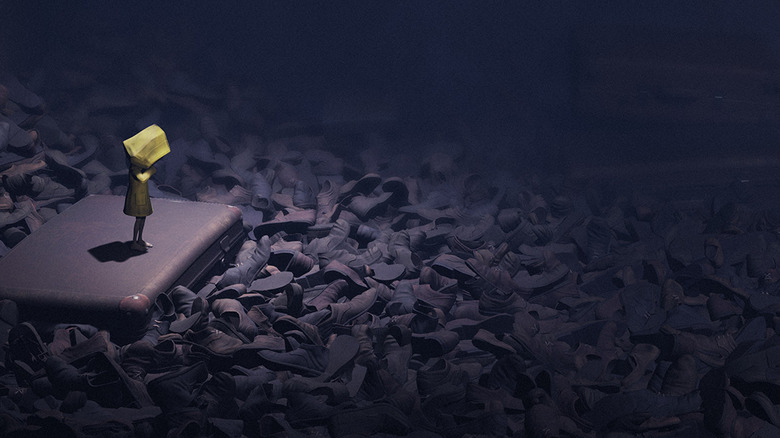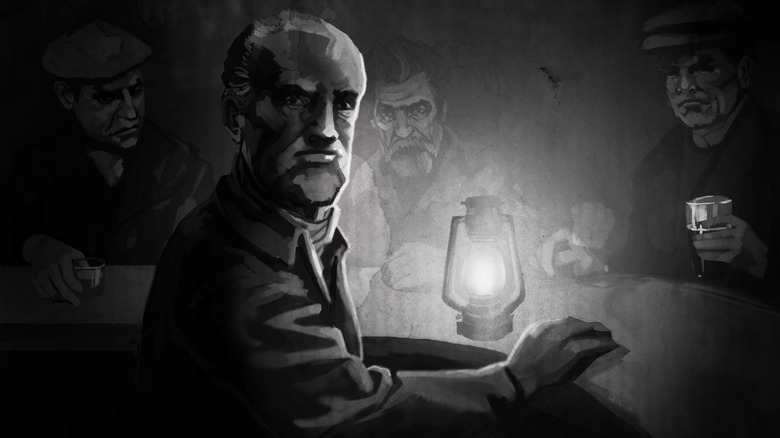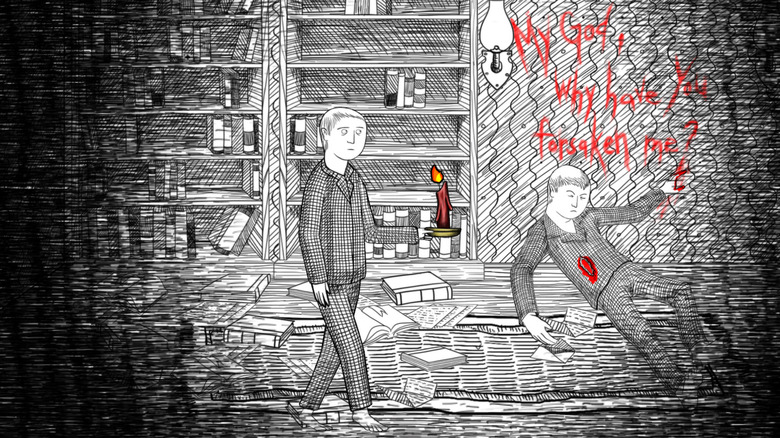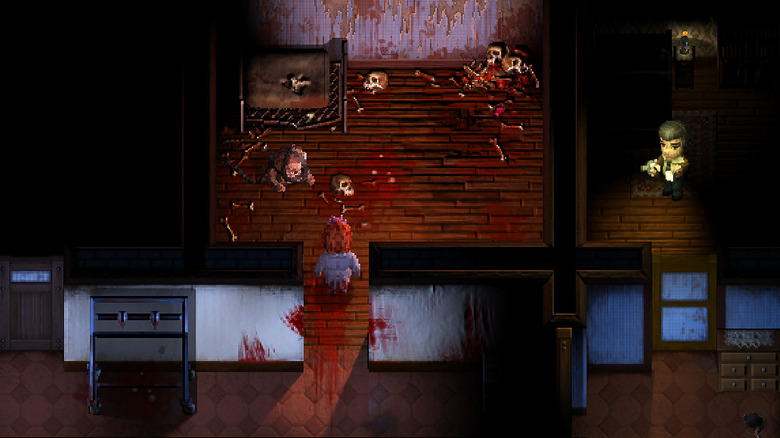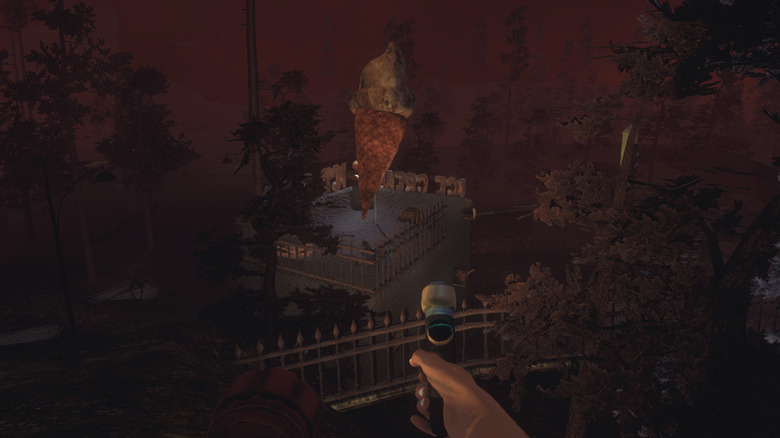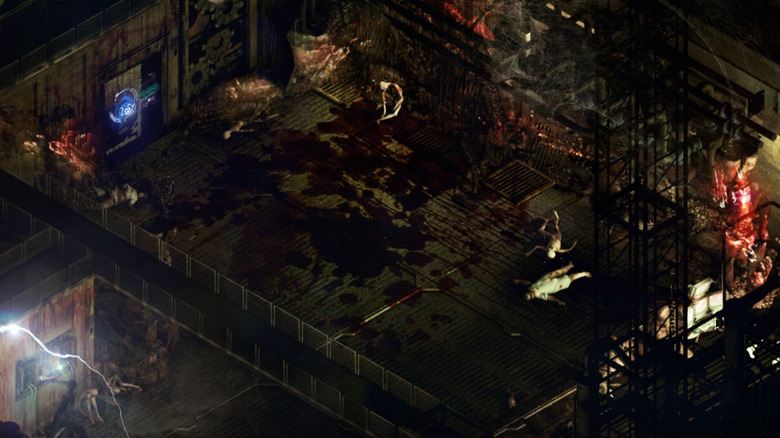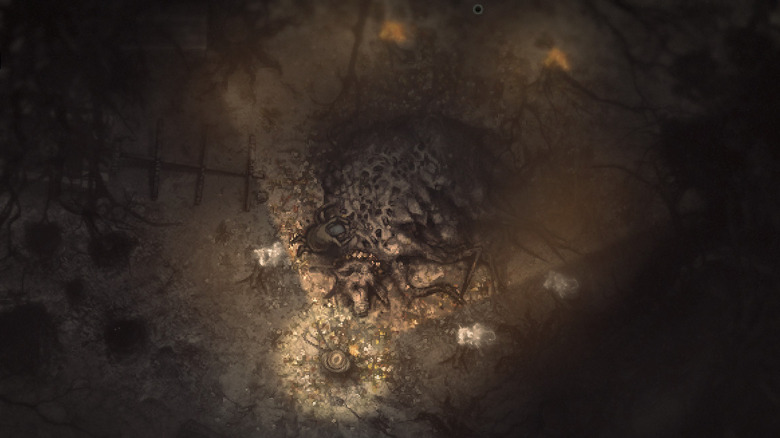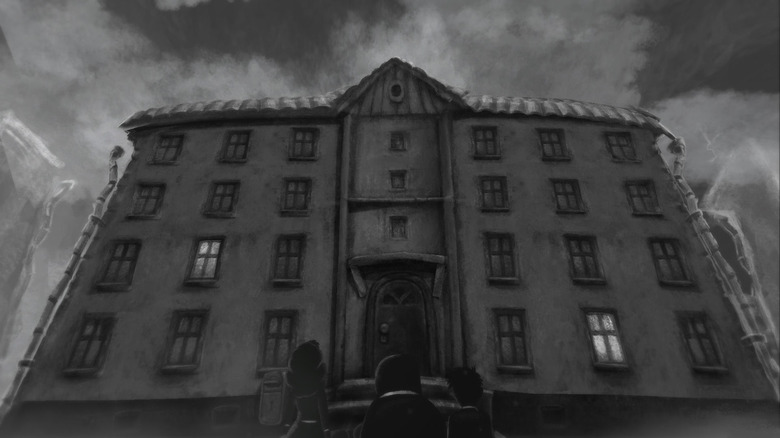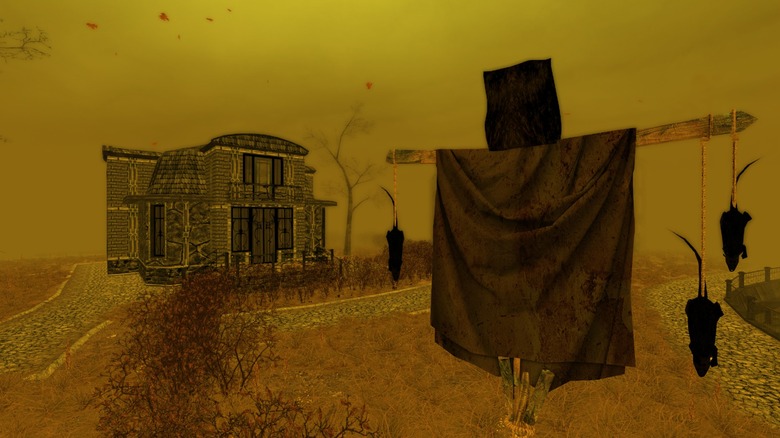The Darkest Games On Steam That Nobody Is Talking About
Video games have a power to immerse us completely in all manner of worlds, from the completely fantastic to the totally realistic. Some of our most immersive game experiences come from being dropped into a twisted, dark world: think of discovering the seedy underbelly of Rapture in BioShock, or the way the atmosphere of Silent Hill set up camp in your brain and refused to move on. However, pretty much everyone has played those two games and are definitely aware of how unsettling they can be. Today, we're shining a light on some of the darkest games on Steam that you may not be familiar with.
Keep in mind that "dark" games do not necessarily constitute "scary" games. While some of these games may certainly be considered horror games, they are more about creating an unsettling atmosphere and making you feel downright uncomfortable, rather than making you jump out of your skin. Read on, and play these Steam titles at your own risk.
Hatred casts you as a maniac only known as "The Antagonist"
Let's start by jumping right into the deep end with Hatred. This violent twin-stick shooter puts you in the boots of "The Antagonist," giving you very little story or context other than your sheer disgust with humanity and desire to cause as much pain and suffering as you can. "Only brutality and destruction can cleanse this land," reads Hatred's Steam page. "Only a killing spree will make you die spectacularly and go to hell."
Levels in Hatred see you moving through different locations, murdering civilians and fighting off authorities who have been sent in to stop you. It is certainly dark and twisted, so much so that Polygon reports Jaroslaw Zielinski, CEO of the game's developer Destructive Creations, had to defend himself against accusations that he was affiliated with Polish Neo-Nazi groups.
Softpedia called Hatred "one of the most controversial games" released in 2015, and Metro Gaming called it "the most violent game on Earth." Its angsty lead character, practically black and white color scheme (except, of course, for things like fire and blood), and desire to shock push it a bit towards the "over-the-top schlock" realm, but it still makes your skin crawl to unleash such unabashed violence in Hatred's world.
Little Nightmares pits a defenseless child against grotesque horrors
If you'd prefer a more subtle darkness, Little Nightmares may be a bit more your speed. It's very reminiscent of indie darlings like Limbo and Inside: you take control of a relatively defenseless character, solving puzzles and avoiding danger. The problem is that you are small in a big world, and seemingly everything wants to kill you.
Little Nightmares puts you inside the bright yellow rain slicker of Six, a small child trying to escape grotesque tormentors in a prison called the Maw. Each of the enemies you face will torment you throughout the game's various acts: the blind janitor with arms that are just a little too long, the bumbling chefs who want to butcher Six for dinner, and a being known only as the Lady, who seems to run the whole show. The story is generally left to the player's imagination, but you can really only imagine something ugly.
Polygon calls it "very creepy" and full of "genuinely disturbing moments." IGN says that Little Nightmares perfectly captures "the creeping fright of waiting to be caught." It's a dream-like game that gets under your skin and makes you feel uncomfortable.
Anchorhead is Lovecraftian interactive fiction
Anchorhead brings somewhat of an elephant into the room: it's a text adventure puzzle game that was originally released in 1998. Hey wait! Where are you going?
Hear me out: Anchorhead may be those things, but it's also a classic Lovecraftian adventure that shamelessly places you in the heart of his creepiest stories. Anchorhead puts you in control of a woman who returns to the titular town, where all sorts of nasty happenings are occurring. You are tasked with unraveling the mystery of Anchorhead, and you will probably die in some horrible ways as you go. PC Gamer describes the game as a highlight reel of Lovercraft's best, bringing in elements of stories like "The Dunwich Horror," "The Thing on the Doorstep," and "The Shadow Over Innsmouth."
Like any Lovecraft story worth its salt, Anchorhead just feels ... wrong. The characters are unsettling, the horrors are powerful but vague, and your imagination does most of the heavy lifting. This is text-driven interactive fiction, after all. There is something extremely compelling about fighting against an unstoppable force beyond your imagination, however. Rock Paper Shotgun might say it best: "This seems a fine time to visit a Massachusetts coastal town and get caught up in something terrible."
Neverending Nightmares is based on a real struggle with mental illness
At first glance, Neverending Nightmares looks to be a bunch of cliched horror ideas thrown together: spooky dolls, bleeding eyes, sanitariums, etc. However, the game itself is so much more: Neverending Nightmares is creator Matt Gilgenbach's direct response to the flop of a previous game he released. Gamespot writes that every image, every scenario, every uncomfortable scene in the game is drawn from his own experience in dealing with depression and obsessive-compulsive disorder.
Neverending Nightmares puts you in the shoes of Thomas, a man struggling with guilt and depression. He dreams of grotesque images and only ever awakens into another awful dream. The pencil-and-paper art style lends itself to the dream-like haze, and the images get creepier and creepier as it goes on. Neverending Nightmares is also unrelenting: Gilgenbach told Endgadget that rather than the ups and downs of most horror games, he wanted Neverending Nightmares to be a "continuous downward spiral" in order to better reflect depression and other mental illness. The game features multiple endings, some in which Thomas turns out okay, and others where things do not get better. The journey through mental illness is more important than the conclusion.
2Dark tasks you with saving children from gruesome fates
You can't get much darker than putting children in peril, and that is the central conceit of Frederick Raynal's 2Dark. Raynal is one of the granddaddies of dark video gaming: in 1992 he was the lead designer of Alone in the Dark, which is the origin of the survival horror genre, according to IGN. 2Dark's main character is a gritty detective named Mr. Smith, who is haunted by the memory of his wife's murder and abduction of his children. He travels to the aptly named town of Gloomywood, where he investigates a series of child abductions. The cases lead him through all sorts of creepy locations, like a dilapidated orphanage and a junkyard. Also, this is one of the few games out there with a plot that hinges on dead children.
2Dark feels surreal, almost intentionally so. Maybe it is trying to distance the player a bit from the grotesque subject matter with its strange writing and ugly, voxel graphics. However, that doesn't always work. The very first level sees the player infiltrating an abandoned carnival that kidnaps children and ships them to people. While they wait to be shipped, the children are dressed like circus animals and tormented by an insane clown/ringmaster. If you don't act quickly, some of the children are mauled by lions.
It's tough to stay distant when those are the stakes at hand.
Sylvio has you hunting ghosts with real world audio techniques
If more traditional scare-'em-ups are your style, Sylvio is a little slice of Silent Hill for modern gaming. Sylvio focuses on a character named Juliette Waters, a ghost hunter who specializes in electronic voice phenomena (EVP). EVP is a real-world ghost-hunting technique that involves analyzing static and background noises of audio recordings in the hunt for supernatural beings.
It's a suitably creepy conceit for a game that makes for some harrowing moments, compounded by the fact that Juliette is stuck in a massive, foggy park simply full of ghosts. Rock Paper Shotgun calls it "imaginative, unusual and frightening," and also gives Sylvio credit for actually tasking players with manipulating the audio to uncover all of the game's secrets. Players must also solve environmental puzzles and, on occasion, hold seances in order to unlock the mysteries around them. Kill Screen writes that Sylvio always manages to capture vivid, dark, and painful experiences and bring them to life.
Stasis is isometric space terror at its best
One of the best ways to bring a dark world to life is to take the player and drop them in a situation where something has already gone horribly wrong, and force them to try to piece together what happened. Stasis does exactly this: it is set in the cold void of space, and the player wakes up from a stasis pod to find that everything has fallen apart around them. Blood covers every surface of the ship, broken machinery lies everywhere, and you have to figure out just what happened. Let's just say that things go from bad to much, much worse before Stasis comes to an end.
Rock Paper Shotgun compares the atmosphere of Stasis to movies like Alien, The Thing, Invasion of the Body Snatchers, and Event Horizon. That's a veritable who's who of science-fiction psychological horror. Destructoid calls it "creepy and unsettling, with scenes sure to embed themselves in the player's mind." Stasis is obviously a frightening game, but it is the implications of that horror that ultimately will stick with you.
Darkwood takes crafting games to a dark place
If you took all the cute stuff from Don't Starve and carved it out with a hacksaw, you'd end up with something like Darkwood. Created by a three person Polish studio called Acid Wizard, Darkwood drops players into a semi-open world where they are tasked with creating a base in the woods and defending it against the monsters that live there. Darkwood is literally a dark game, where exploring the woods limits your perspective and forces you to use your limited supply of light in order to stay safe.
Darkwood is also a dark game in that it swerves your expectations. There is nothing that innovative about "monsters hunting you through the woods," but publications like PC Gamer make a good point: why is the werewolf wearing a hoodie and hunting you through the woods with an assault rifle? Just what is happening in this world? Darkwood plays with your expectations and uses its procedurally generated worlds to mess with your head. It only gets more disturbing as it moves towards its conclusion.
Beholder casts you as a spy for a totalitarian government
Not every dark game pits you against literal monsters. Sometimes you have to push back, often in futility, against evil people: a figurative monster you are trying to stop. Often, the best dark games make you wonder if you, yourself, have become the monster. That's what Beholder does best: it forces you to question your own morality while you work within the game's parameters.
Beholder puts you in the shoes of Carl, a rising star in a totalitarian government. The state government appoints you to be the landlord of an apartment complex, and that's where things start to get ugly. You are supposed to report on your tenants, including their private affairs. How? By spying on them. Carl watches through peepholes, he installs cameras, and he rummages through belongings. Beholder makes your skin crawl by forcing you to become terrible, and it makes you question just how far you will go in order to achieve your goals.
Rock Paper Shotgun says that Beholder is inspired by the works of George Orwell, and you can definitely see that in the unsettling surveillance state it establishes.
Pathologic Classic HD is a bizarre RPG about saving a town from a plague
In Pathologic, a remastering of the bizarre 2005 RPG, players can control one of three characters, known only by their titles: the Bachelor, the Haruspex, and the Changeling. The story is the same regardless of who you choose, but each character experiences it from different angles and interacts with different people. That means you will need to complete the game as all three characters in order to see the whole picture. The story revolves around a mysterious town that is being destroyed by a disease called the sand plague. It sounds pretty straightforward ... but it isn't. Trust us on this one: Pathologic is one bizarre trip.
PC Gamer describes the game as "incomprehensible" and wrote "the weirdness runs deep" as far as the plot goes. Rely on Horror calls it a mood piece and an "incredibly twisted game." Really, the less said about where the plot turns in Pathologic Classic HD, the better. Just know you're in for a stroll through the darkness. This remaster not only updates the graphics to look a bit more modern, but it also features a much more accessible translation than the original so that the game is not quite so unintentionally difficult.

